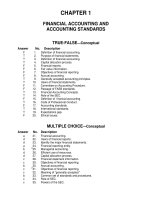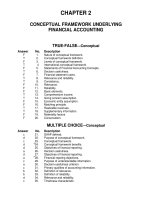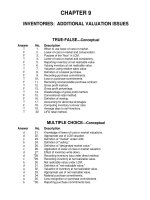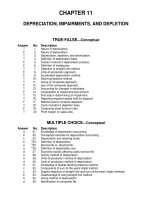Intermediate accounting 16e by kieso slide ch04
Bạn đang xem bản rút gọn của tài liệu. Xem và tải ngay bản đầy đủ của tài liệu tại đây (2.31 MB, 76 trang )
4-1
PREVIEW OF CHAPTER 4
4-2
Intermediate Accounting
16th Edition
Kieso ● Weygandt ● Warfield
4
Income Statement and
Related Information
LEARNING
LEARNINGOBJECTIVES
OBJECTIVES
After studying this chapter, you should be able to:
1 Understand the uses and
limitations of an income
statement.
2 Describe the content of the
income statement.
3 Prepare an income statement.
5 Understand the reporting of
accounting changes and errors.
6 Prepare a retained earnings
statement.
7 Explain how to report other
comprehensive income.
4 Explain how to report various
income items.
4-3
LO 1
INCOME
INCOME STATEMENT
STATEMENT
Usefulness
Evaluate past performance.
4-4
Predicting future performance.
Help assess the risk or uncertainty of
achieving future cash flows.
LO 1
INCOME
INCOME STATEMENT
STATEMENT
Limitations
Companies omit items that cannot be
measured reliably.
4-5
Income is affected by the accounting
methods employed.
Income measurement involves
judgment.
LO 1
INCOME
INCOME STATEMENT
STATEMENT
Quality of Earnings
Companies have incentives to manage income to meet or
beat Wall Street expectations, so that
market price of stock increases and
value of stock options increase.
Quality of earnings is reduced if earnings management
results in information that is less useful for predicting future
earnings and cash flows.
4-6
LO 1
WHAT DO THE NUMBERS MEAN? FOUR:
THEYOUR
LONELIEST
NUMBER
WHAT’S
PRINCIPLE
Managing earnings up
or down adversely
affects the quality of
earnings. Why do
companies engage in
such practices? Some
recent
research
concludes that many
companies
tweak
quarterly earnings to
meet
investor
expectations. How do
they do it? Research
findings indicate that companies tend to nudge their earnings numbers up by a
10th of a cent or two. That lets them round results up to the highest cent, as
illustrated in the following chart. What the research shows is that the number
4-7
continued
LO 1
WHAT DO THE NUMBERS MEAN? FOUR:
THEYOUR
LONELIEST
NUMBER
WHAT’S
PRINCIPLE
“4” appeared less often in the 10th’s place than any other digit and significantly
less often than would be expected by chance. This effect is called
“quadrophobia.” For the typical company in the study, an increase of $31,000 in
quarterly net income would boost earnings per share by a 10th of a cent. A
more recent analysis of quarterly results for more than 2,600 companies found
that rounding up remains more common than rounding down. Another recent
study reinforces the concerns about earnings management. Based on a survey
of 169 public-company chief financial officers (and with in-depth interviews of
12), the study concludes that high-quality earnings are sustainable when
backed by actual cash flows and “avoiding unreliable long-term estimates.”
However, about 20 percent of firms manage earnings to misrepresent their
economic performance. And when they do manage earnings, it could move
EPS by an average of 10 percent. Is such earnings management a problem for
investors? It is if they cannot determine the impact on earnings quality. Indeed,
the surveyed CFOs “believe that it is difficult for outside observers to unravel
earnings management, especially when such earnings are managed using
4-8
(continued)
LO 1
WHAT DO THE NUMBERS MEAN? FOUR:
THEYOUR
LONELIEST
NUMBER
WHAT’S
PRINCIPLE
survey authors say the CFOs “advocate paying close attention to the key
managers running the firm, the lack of correlation between earnings and cash
flows, significant deviations between firm and peer experience, and unusual
behavior in accruals.”
Sources: S. Thurm, “For Some Firms, a Case of ‘Quadrophobia’,” Wall Street Journal
(February 14, 2010); and H. Greenberg, “CFOs Concede Earnings Are ‘Managed’,”
www.cnbc.com (July 19, 2012). (The study referred to is by I. Dichev, J. Graham, C.
Harvey, and S. Rajgopal, “Earnings Quality: Evidence from the Field,” Emory University
Working Paper (July 2012).)
4-9
LO 1
4
Income Statement and
Related Information
LEARNING
LEARNINGOBJECTIVES
OBJECTIVES
After studying this chapter, you should be able to:
1 Understand the uses and
limitations of an income
statement.
2 Describe the content of the
income statement.
3 Prepare an income statement.
5 Understand the reporting of
accounting changes and errors.
6 Prepare a retained earnings
statement.
7 Explain how to report other
comprehensive income.
4 Explain how to report various
income items.
4-10
LO 2
FORMAT
FORMAT OF
OF THE
THE INCOME
INCOME STATEMENT
STATEMENT
Elements of the Income Statement
Revenues – Inflows or other enhancements of assets or
settlements of its liabilities that constitute the entity’s ongoing
major or central operations.
Examples of Revenue Accounts
4-11
Sales
Dividend
Fee
Rent
Interest
LO 2
FORMAT OF THE INCOME STATEMENT
Elements of the Income Statement
Expenses – Outflows or other using-up of assets or
incurrences of liabilities that constitute the entity’s ongoing
major or central operations.
Examples of Expense Accounts
4-12
Cost of goods sold
Rent
Depreciation
Salaries and wages
Interest
Taxes
LO 2
FORMAT OF THE INCOME STATEMENT
Elements of the Income Statement
Gains – Increases in equity (net assets) from peripheral or
incidental transactions.
Losses - Decreases in equity (net assets) from peripheral or
incidental transactions.
Gains and losses can result from
4-13
sale of investments or plant assets,
settlement of liabilities,
write-offs of assets.
LO 2
4
Income Statement and
Related Information
LEARNING
LEARNINGOBJECTIVES
OBJECTIVES
After studying this chapter, you should be able to:
1 Understand the uses and
limitations of an income
statement.
2 Describe the content of the
income statement.
3 Prepare an income statement.
5 Understand the reporting of
accounting changes and errors.
6 Prepare a retained earnings
statement.
7 Explain how to report other
comprehensive income.
4 Explain how to report various
income items.
4-14
LO 3
FORMAT OF THE INCOME STATEMENT
Intermediate Components
Format referred to as multiple-step income
statement.
4-15
Separates operating transactions from nonoperating
transactions.
Matches costs and expenses with related revenues.
Highlights certain components of income that analysts
use assessing financial performance.
LO 3
Intermediate
Intermediate Components
Components
Common for companies to present some or all of the
following sections and totals within the income statement.
1. Operating section
2. Nonoperating section
3. Income tax
4. Discontinued operations
5. Noncontrolling interest
6. Earnings per share
4-16
LO 3
Multiple-Step
Multiple-Step
CABRERA COMPANY
Income Statement
For The Year Ended December 31, 2017
1. Operating Section
2. Nonoperating
Section
3. Income tax
4-17
ILLUSTRATION 4-2
WHAT DO THE NUMBERS MEAN?
TOP LINE
OR BOTTOM
LINE?
WHAT’S
YOUR
PRINCIPLE
The importance of the components of income, as well as the bottom line, is
illustrated in the recent case of Chipotle. Its stock had climbed fourfold in five
years and for good reason. The company had been reporting surprisingly high
bottom-line income and investors were clamoring to buy. However, in a recent
month, that pattern was broken—that is, Chipotle posted solid earnings, but
investors sold. The reason? Analysts attribute the sell-off to Chipotle missing its
target for revenues. The stock fell 21 percent, from $404 to $317, in a day. And
Chipotle was not alone. Six in 10 large companies reported results in that same
quarter that missed revenue targets. In response to the bad revenue news,
Priceline.com fell $117 to $562 after reporting revenue that was lower than
analysts had expected. The story has been the same for dozens of companies
across industries, from Coach, a luxury goods retailer, to Boston Scientific,
which sells medical devices, to glass-container maker Owens-Illinois. The
recent focus on the top line, revenue, arises because market expectations for
revenues do not seem to jive with the companies’ optimistic profit picture. And
while companies might report a surprise in earnings,
4-18
(continued)
LO 3
WHAT DO THE NUMBERS MEAN?
TOP LINE
OR BOTTOM
LINE?
WHAT’S
YOUR
PRINCIPLE
analysts will be focusing on revenues. Companies have been able to cut costs
to compensate—laying off workers, squeezing remaining staff, and using
technology to run more efficiently—but there’s a limit to how much you can
squeeze your workers and use technology to produce more. U.S. companies
are just about as lean as any time in history. As one analyst noted (in this
economic environment), “you won’t be able to grow earnings much faster than
revenue. . . . Analysts will have to revise down their earnings.” So watch the top
line, as well as the bottom line.
Source: Associated Press, “Why Some Stocks Are Sinking Despite Big Profits,” The New
York Times (August 12, 2012)
4-19
LO 3
Condensed
Condensed Income
Income Statements
Statements
4-20
ILLUSTRATION 4-3
Condensed Income
Statement
FORMAT
FORMAT OF
OF THE
THE INCOME
INCOME STATEMENT
STATEMENT
Single-Step Income
Statements
Revenues
Expenses
SingleStep
Net Income
No implication that one
type of revenue or
expense item has priority
over another.
4-21
ILLUSTRATION 4-5
Single-Step Income Statement
LO 3
FORMAT
FORMAT OF
OF THE
THE INCOME
INCOME STATEMENT
STATEMENT
Illustration (E4-5): Prepare a
income statement from the data
below using the multiple-step
form.
4-22
LO 3
FORMAT
FORMAT OF
OF THE
THE INCOME
INCOME STATEMENT
STATEMENT
Question
A separation of operating and non operating activities of a
company exists in
a. both a multiple-step and single-step income statement.
b. a multiple-step but not a single-step income statement.
c. a single-step but not a multiple-step income statement.
d. neither a single-step nor a multiple-step income
statement.
4-23
LO 3
4
Income Statement and
Related Information
LEARNING
LEARNINGOBJECTIVES
OBJECTIVES
After studying this chapter, you should be able to:
1 Understand the uses and
limitations of an income
statement.
2 Describe the content of the
income statement.
3 Prepare an income statement.
5 Understand the reporting of
accounting changes and errors.
6 Prepare a retained earnings
statement.
7 Explain how to report other
comprehensive income.
4 Explain how to report various
income items.
4-24
LO 4
REPORTING
REPORTING VARIOUS
VARIOUS INCOME
INCOME ITEMS
ITEMS
Companies are required to report unusual and infrequent
items as part of net income so users can better determine the
long-run earning power of the company.
These income items fall into four general categories:
1. Unusual gains and losses
2. Discontinued operations
3. Noncontrolling interest
Modified all
inclusive concept
4. Earnings per share
4-25
LO 4









